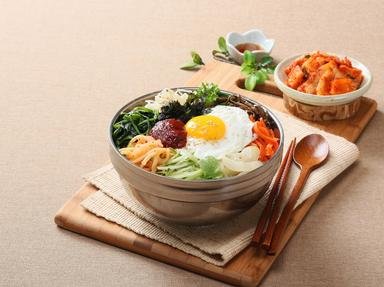Quiz Answer Key and Fun Facts
1. Kimchi is one of South Korea's most famous foods, a dish of fermented vegetables. Pictured here is baechu kimchi, or 'cabbage kimchi', one of the most recognisable kinds of kimchi. Which kind of cabbage is most commonly used to make baechu kimchi?
2. What is the name of the sweet, hot chilli paste pictured here, made from chilli powder and glutinous rice?
3. Doenjang jjigae is a type of stew, or jjigae, considered to be one of the national dishes of South Korea. What kind of ingredient is 'doenjang'?
4. Pictured here are tteokbokki. At first glance, they may look like tubes of pasta, but what actually are they?
5. Bulgogi is a popular South Korean meat dish, where the meat is often cooked on a grill. What type of meat is usually used in bulgogi?
6. The dish pictured here is a mixture of rice and vegetables, topped off with an egg. Its name translates 'mixed rice', but what is the Korean name of this dish?
7. In Japanese restaurants, you might be able to order norimaki, or sushi wrapped in nori seaweed. What is the South Korean equivalent, pictured here?
8. This vegetable dish here, or namul, is oi muchim, a type of salad. Which watery green vegetable, which is also used in Indian raita and as an English sandwich filling, is the staple vegetable used in oi muchim?
9. Dak-galbi is a chicken dish associated with the city of Chuncheon in the South Korean province of Gangwon. It is a type of dish known as a 'bokkeum', after the method in which it is cooked. What is the method used for cooking a bokkeum?
10. Now for something sweet! Candied sweet potatoes are a popular Thanksgiving side dish in many parts of the US, and they're also a dessert of choice in South Korea. What is the Korean name for candied sweet potatoes?
Source: Author
Kankurette
This quiz was reviewed by FunTrivia editor
jmorrow before going online.
Any errors found in FunTrivia content are routinely corrected through our feedback system.
